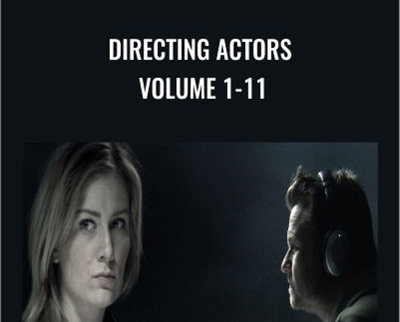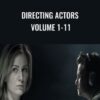$499.00 Original price was: $499.00.$73.00Current price is: $73.00.
Years in the making, Directing Actors is the most comprehensive acting and directing training in the world. Created by Per Holmes, the course teaches a better way to be a Director, by having extremely strong technique, and the right philosophy and personality on the set.
 Purchase this course you will earn 73 Points worth of $7.30
Purchase this course you will earn 73 Points worth of $7.30Elevate your skills with the Directing Actors Volume 1-11 – Hollywood Camera Works course, available for just $499.00 Original price was: $499.00.$73.00Current price is: $73.00. on Utralist.com! Browse our curated selection of over 60,000 downloadable digital courses across diverse Uncategorized. Benefit from expert-led, self-paced instruction and save over 80%. Start learning smarter today!
A Journey to a Mind-Set
Years in the making, Directing Actors is the most comprehensive acting and directing training in the world. Created by Per Holmes, the course teaches a better way to be a Director, by having extremely strong technique, and the right philosophy and personality on the set.
Through over a thousand examples, we cover literally every acting and directing technique, every interaction between Actor and Director, and we cast, rehearse and shoot 9 scenes.
Directing Actors is the result of Per Holmes' personal obsession with resolving once and for all the best way to work with Actors. Every known technique has been tested, and the results are surprising, sometimes shocking.
Directing Actors has involved almost 150 people through 7 years of development and 5 years of shooting and editing, including over 50 Actors who have gracefully allowed us to show the process without any filters.
A GROUND-BREAKING COURSE
Directing Actors is an ultra-comprehensive course that shatters myths about how you're supposed to work with Actors.
DIRECTING WITH NEW EYES
Through 7 years of development and 3 years of shooting and editing, the course reevalutates every known acting and directing technique, and paints a striking new picture.
A MUCH BIGGER PICTURE
Part I builds an unparalleled language of acting and directing technique. Part II puts it to use by casting, rehearsing and shooting 9 scenes
AN AMAZING ACTING CLASS
You can't talk directing without talking acting. Directing Actors is a truly comprehensive acting class that covers more ground than any book, class or video.
A NEW RELATIONSHIP
Great acting comes not just from great technique, but from the climate around it. Directing Actors shows you a better philosophy, and a more evolved way of working with Actors.
STRUCTURE OF THE COURSE
Directing Actors is divided into two major parts. Part I is the theory-section, and is more about individual techniques than creating full characters. In Part II, it all clicks together as we cast, rehearse and shoot 9 scenes. Here, we can for the first time see how the techniques come together to create living, breathing characters.
Get Directing Actors Volume 1-11 – Hollywood Camera Work, Only Price $77
PART I
VOLUME 1: NATURAL ACTING
On the first volume, which you can watch in its entirety here, we lay the philosophical groundwork by understanding which part of the character actually comes from the acting. We talk about how not seeing the story character and not accepting yourself as you are results in pushy acting.
A HUGE PRODUCTION
Almost a hundred talented Actors were part of making this course.
VOLUME 2-8: ACTIVE IDEAS
Active Ideas are the thoughts that produce behavior. What we're looking for is simple thoughts that are easy to think, but that produce complex behavior that runs effortlessly by itself.
There are certain categories of thoughts at the heart of every good acting technique. On Volume 2-8, we not only map every every Active Idea that's known to work, we add a new level of understanding, and we re-evaluate many myths, for example that result directing is bad or that active verbs are good, which is not that simple.
FILM ACTING
While character work is the same in film and theatre, the practical techniques and tricks you use to fit into the medium are extremely different. Directing Actors is biased towards film acting.
THE LAYERS OF BEHAVIOR
One of the major original contributions of the course is the Layers Of Behavior. Every known acting technique fits neatly into this single concept, and once you realize the connection, it becomes strikingly clear how all acting techniques relate.
It's like each Layer Of Behavior hits a unique psychological frequency. For example, working with objectives is distinct from working with the character's future, or his past, or his present projections, which are distinct from working with his self-image or physical actions or emotional state.
You will see how most Actors and Directors have made their home on just one or two layers, but that rich, nuanced performances come from activating more psychological aspects. This is the most brain-crunching part of the course, but it will take your competence to a new level, both as an Actor or a Director.
PART II
VOLUME 9-10: CASTING
It's really true that if you cast someone right, most of your work is already done. Directing Actors takes you through a full casting process, where you learn how to find out if someone is right for the part, whether they can really act, what positive and negative signs to look for, and how to direct during the audition so you get real data.
We're also interested in how to run the casting session, and how to create an environment that encourages Actors to reveal their talents. We discuss everything from how to arrange the casting space, to how to videotape it, going through callbacks, ending in test-pairings of potential leads.
Whether you're a Director or an Actor, sitting in on a casting is an enlightening, but also emotionally painful process.
A FULL CASTING PROCESS
Learn how to tell if somebody is right for the part, how to find out if they can really act, and what positive and negative signs to look for
AN EYE-OPENER FOR ACTORS
Nothing will teach you more about auditioning than watching an unfiltered casting process from the Director's perspective.
As you join in the decision-making process, you can suddenly see what the Director sees, and this may change your whole outlook on auditioning.
VOLUME 11: REHEARSAL
The next two volumes are part of a Directing Workflow from rehearsal through shooting, in super slow-motion so we can analyze everything. Starting with rehearsal, this is something many people skip, thinking it'll make the characters more spontaneous
But not rehearsing makes the characters hollow and empty, you'll have no toolbox or common language on the set, and the acting won't be ready for prime time.
SIMPLICITY
When you learn what is truly involved in creating a character, you can only be humble, and the relationship becomes one of simple collaboration.
VOLUME 12: DIRECTING WORKFLOW
We're now working on the set in super slow-motion, and we're interested in the entire conversation, what you say when, what you don't say when, how to motivate, and how to criticize constructively. We're also interested in solving every problem that comes up, like nervous actors, or pulling the scene back from a bad place.
We're solving many special situations like interruptions, or performing around missing actors, or when (not) to do rolling resets, as well as cleaning up the production so Actors can concentrate on acting.
NO FEAR
Many Directors are afraid of saying the wrong thing to Actors. But once you understand how acting really works, you start to relate on a deep level to what Actors do. We're only superficially different.
VOLUME 13-17: REAL-TIME DIRECTING
We're now rehearsing and shooting for the last six volumes. This is where we turn on the storm and work at full speed using everything we've learned. This is the first time we can truly see how the techniques come together to create living, breathing characters.
We're covering lots of new ground in this part as things come up during the shoot. And the scenes are chosen for their issues, for example a love scene, or emotional and physical violence, which requires special handling.
FULL PRODUCTION
We're shooting the 9 scenes under real circumstances and pressures. You will learn how to keep your eye on the ball and be character-centric even as you're being pulled at from all directions.
CRIME DRAMA (4 SCENES)
We're doing 4 scenes from a ficticious crime drama featuring a detective Lily (played by Lee Stark), who is emotionally detached due to childhood trauma and has no interest or experience with personal relationships.
The character Reynold (played by Karl Hamilton) became disturbed after his daughter was murdered, and his mission in life is to expose the person who did it. He's an loner and a conspiracy-theorist, he lives in his car, and sees Lily as his only friend, but she's neither willing nor able.
Through rehearsals and shooting 4 scenes at different points in the character arcs, you will see how the characters take shape as we discover their behavior and find what works for the Actors. You will recognize techniques as they happen in quick succession.
A NEW NORMAL
Countless beliefs about how you should direct Actors are based on an already broken relationship. Without a broken relationship, many
of those beliefs are no longer true.
PSYCHOPATH DRAMA (4 SCENES)
A psychopath, Leonard (played by David Scott Crawford), has moved into a wealthy neighborhood, and has everyone fooled that he's a cool tech CEO. His next victim, Elaine (played by Maggie Scrantom), is a controlling and bored housewife, whom he decides to kill after she makes some minor comment. Elaine's husband, Lawrence (played by Pete Navis) is mesmerized by Leonard, and doesn't pick up obvious signals.
These scenes were chosen for the course because a psychopath has no obvious behavior, and is hard to play. The scene also includes physical violence, which is emotionally difficult to shoot, and it needs specific handling on the part of the Director.
A FULL RANGE
We need to be willing to explore any side of the human psyche, including truly nasty characters. Our job is not to fix it, our job is to represent it truthfully.
POLITICAL DRAMA (LOVE SCENE)
A congressman, Frank (played by Pete Navis) has been promising his staffer and lover Lisa (played by Laura Obenauf) that he will divorce his wife. Lisa dreams of becoming a first lady, and has believed him in spite of many broken promises. But in this scene, it becomes clear that it's never happening.
Love scenes, as well as any scenes that deal in raw emotions or violations of personal boundaries, need to be directed in certain ways, so the Actors can feel safe in committing to the part.
BE A LEADER
Being a better Director is not only about technique. It is about changing your role as a leader. We're always in uncharted territory, because we've never shot this movie before. Directing is knowing how to lead your team of explorers on a journey of discovery.
Get Directing Actors Volume 1-11 – Hollywood Camera Work, Only Price $77
Tag: Directing Actors Volume 1-11 – Hollywood Camera Work Review. Directing Actors Volume 1-11 – Hollywood Camera Work download. Directing Actors Volume 1-11 – Hollywood Camera Work discount.directing actors judith weston. directing actors techniques. directing actors adrienne weiss. redirecting non actors book. directing actors course london
Cultivate continuous growth with the Directing Actors Volume 1-11 – Hollywood Camera Works course at Utralist.com! Unlock lifetime access to premium digital content, meticulously designed for both career advancement and personal enrichment.
- Lifetime Access: Enjoy limitless access to your purchased courses.
- Exceptional Value: Benefit from savings up to 80% on high-quality courses.
- Secure Transactions: Your payments are always safe and protected.
- Practical Application: Gain real-world skills applicable to your goals.
- Instant Accessibility: Begin your learning journey immediately after buying.
- Device Compatible: Access your courses seamlessly on any device.
Transform your potential with Utralist.com!
Related products
Uncategorized
Legal Risks in Nursing Documentation – Use Extreme Caution When Skimming the Facts – Rosale Lobo
= 40 Points
= 65 Points
= 125 Points
= 85 Points
Uncategorized
Cognitive Rehabilitation Therapy: Practical Interventions and Personalized Planning – Jane Yakel
= 85 Points
Uncategorized
= 85 Points
Uncategorized
= 30 Points
= 72 Points





